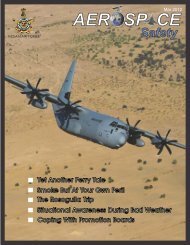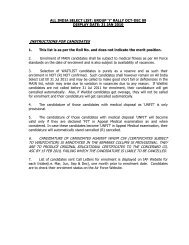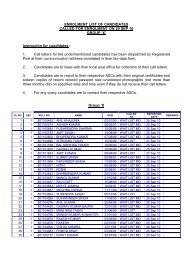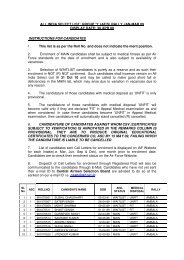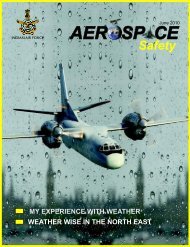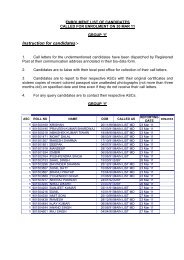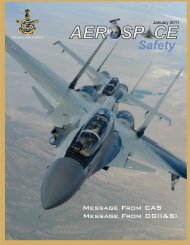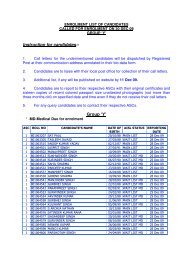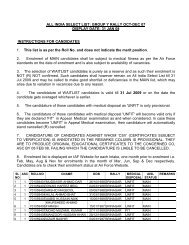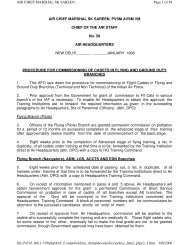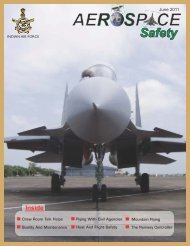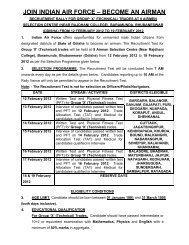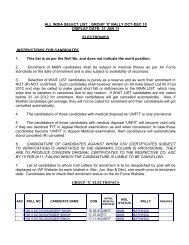February 2010 - Indian Airforce
February 2010 - Indian Airforce
February 2010 - Indian Airforce
You also want an ePaper? Increase the reach of your titles
YUMPU automatically turns print PDFs into web optimized ePapers that Google loves.
MANY people use the terms ‘leadership’ and<br />
‘management’ interchangeably. However, these<br />
words imply a number of different things in<br />
spite of being quite similar. Management in the simplest<br />
words means getting the job done through others.<br />
Hence a manager is a person who gets work done. From<br />
the functional perspective, a manager is the one who<br />
plans, organises, controls and directs. Leadership can be<br />
defined as the art of inspiring and influencing people<br />
so that they work willingly towards achieving goals laid<br />
down by their leader. Thus every manager is a leader to<br />
that extent. But the question is, “Does the Air Force need<br />
leaders or managers?”<br />
Often it is said that so and so leader has brought a<br />
dramatic change e.g. Lee Lacocca credited with turning<br />
around the loss making American<br />
auto giant Chrysler. Thus leadership<br />
is associated with change or<br />
transformation. A manager on<br />
the other hand is identified<br />
more with ensuring stability<br />
and predictability in the<br />
organisation. In the Air<br />
Force context, if we say<br />
‘so and so person was<br />
instrumental in the<br />
smooth conduct of<br />
the Op exercise’, we are<br />
referring to the person<br />
as a manager rather than a<br />
leader.<br />
Leadership is visionary<br />
whereas management is rational. A<br />
leader can see the ‘big picture’ and lay<br />
down the goal which the organisation<br />
should reach in the future. Personal vision of Ratan Tata<br />
could be summarised as “I will build a motor car that<br />
will cost not more than one lakh rupees so that the<br />
<strong>Indian</strong> masses can enjoy a four wheeler ride.” It was the<br />
managers in TELCO who through rational planning and<br />
other activities implemented the vision of their leader<br />
and produced the Nano car. The leadership of the Royal<br />
Singapore Air Force has the vision of “Zero Accident” and<br />
has laid it down as its primary goal. Thus, a leader creates<br />
vision and a manager implements it.<br />
A leader is warm, radiant and inspiring. A manager is<br />
often seen as cool and reserved. A leader relates himself<br />
with people who in turn identify themselves with him<br />
or her. A leader reaches out to people, penetrates their<br />
hearts and touches their soul. People start considering<br />
A leader can see<br />
the ‘big picture’ and lay<br />
down the goal which the<br />
organization should reach<br />
in the future. Personal vision of<br />
Ratan Tata could be summarized as<br />
“I will build a motor car that will cost<br />
not more than one lakh rupees so that<br />
the <strong>Indian</strong> masses can enjoy the four<br />
wheeler ride.” It was the managers<br />
in TELCO who through rational<br />
planning and other activities<br />
implemented the vision of<br />
their leader and produced<br />
the Nano car.<br />
the vision and ideas of the leader as their own. In contrast,<br />
a manager is often seen as a person sitting in his chamber<br />
who maintains a distance from his subordinates. Field<br />
Marshal Rommel used to fight along with his soldiers<br />
in the trenches. A leader can be a source of inspiration<br />
to millions. We often hear many great men saying, “I am<br />
inspired by Mahatma Gandhi and his ideology of nonviolence.”<br />
We talk of the Mahatma as being one of the<br />
greatest leaders (not the managers) of the world.<br />
A leader needs to be innovative and imaginative<br />
whereas a manager is more deliberate and analytical. A<br />
leader often uses simple but new and creative approaches<br />
to solve the profoundest of the problems. A manager<br />
on the other hand uses the existing framework of tools<br />
and practices for his day to day work. Leaders love<br />
experimentation but managers hesitate<br />
in doing that. It can be safely said<br />
that a manager uses the existing<br />
framework, approach and ideas<br />
whereas the leader creates new<br />
framework, approach and<br />
ideas.<br />
Now the question<br />
arises “Should the air<br />
warriors be leaders<br />
or managers?” The<br />
Air Force has a well<br />
designed system of rules<br />
and regulations in the form<br />
of various orders, instructions,<br />
policies and directives. Rules<br />
and<br />
regulations are needed<br />
to maintain<br />
order, stability and<br />
predictability in the system. In this<br />
context, the Air Force needs ‘managers’.<br />
A commanding officer or a flight commander has to lead<br />
his team to fight the enemy or accomplish a mission. In<br />
this context, the Air Force needs ‘leaders’. We are often<br />
reminded of many of our great leaders like the Marshal of<br />
the Air Force Arjan Singh who led the IAF outstandingly<br />
during the 1965 air operations.<br />
The IAF still has a long way to reach the ultimate goal<br />
of ‘Zero Accident Rate or ZAR’. To achieve such goals we<br />
need leaders who can bring a dramatic change in the<br />
attitude and working culture of our air warriors and make<br />
them really believe and follow the motto ‘Perfection and<br />
Zero Defect in whatever we do” so that ZAR becomes a<br />
reality.<br />
Wg Cdr Arvind Kumar AE(L) is posted to 5 Wg AF.<br />
INDIAN AIR FORCE 2 01 0 F e b r u a r y Flight Safety 17



